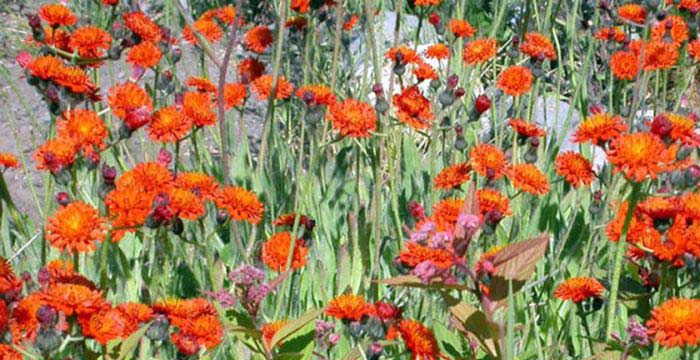Orange hawkweed (Hieracium aurantiacum) is a fairly new invasive weed in Clackamas County and, with your help, our WeedWise team plans to keep it from becoming a common problem for landowners!
A member of the sunflower family, orange hawkweek is native to central and southern Europe and grows in areas of poor soil like gravel pits, roadsides, hay fields, pastures, and other disturbed sites. This is a Class A noxious weed here in Oregon, which means it is a weed of known economic importance which occurs in small enough infestations to make eradication or containment possible.
Orange hawkweed has been around for a long time. It was given the name “hawkweed” by the Roman naturalist, Pliny, who thought that hawks consumed this plant to improve their eyesight. While we are not sure if hawks eat this noxious weed, we do know that landowners cannot count on livestock to graze it down — they find it unpalatable and avoid it!
How Can I Identify Orange Hawkweed?
Also known as “devil’s paintbrush,” orange hawkweed produces orange flower heads that look similar to common dandelion. The stems are usually leafless, stiff, and hairy, and above ground runners create dense mats of plants. All parts of the plant exude a milky sap when cut.
Late spring and early summer is a great time to be on the look out for this noxious weed. Plant height can reach between 10″ – 20″ inches and orange hawkweed is the master of speedy reproduction. It can propagate from seed, runners, and division or disturbance of its rhizomes!
Our colleagues at the Oregon Department of Agriculture have recently published a video on meadow hawkweed and orange hawkweed that can prove helpful in learning to identify these invasives.
Why Should I Care About Orange Hawkweed?
Orange hawkweed displaces native plants and forms monocultures. It spreads at an alarming speed and is one of the rare plants that not only prevents other plants from germinating by crowding them out, but the pollen from an orange hawkweed will interfere with the pollination process of other plants. Each flower produces a generous amount of tufted seed which disperses on the wind and which can lie dormant in the ground for years.
People are often surprised at the attractiveness of the plant and choose to keep and enjoy it. This decision is quickly regretted when the plant rapidly spreads, crowding out and killing other desired plants. But don’t just take our word for it. From an online gardening forum:
- I have this growing everywhere and it is smothering all other plants – having read all other comments, I will continue to dig up as much as possible and cut off any remaining flowers – Ive warned my neighbors to kill on first sight!
- This plant has totally destroyed my own and neighboring gardens. I too thought it pretty at first, now I wish I had a flame thrower though doubt if that would even do it, I spend a fortune on weedkillers every year just to try to keep some free areas.
- I removed this from the ‘proper’ garden to the meadow. Needless to say it’s now in both places.
How Can I Control Orange Hawkweed?
Prevention is the preferred method of control! To prevent spread of existing populations of this invasive weed, carefully clean equipment, vehicles, boots, clothing, and pets after visiting an infested site. Mowing can reduce seed production, but may increase vegetative spread.
Hand pulling can be effective for small infestations, but one must take care to remove the deep, fibrous root and ALL of the below ground rhizomes. Hand pulled plants should be bagged and thrown away or burned. Do not dump pulled weeds or the infestation will just begin anew in another area.
For larger patches of orange hawkweed, our WeedWise team recommends using an herbicide application in spring, followed by hand pulling in early summer before seeds develop. For more information on chemical control of this invasive plant, please contact our WeedWise team at 503-210-6000.
Report Orange Hawkweed!
Have you noticed invasive orange hawkweed in your area? If so, please report your sightings to the District’s WeedWise program by giving them at call at 503-210-6000, or submit your information online to the Oregon Invasive Species hotline. Your help in identifying and reporting locations of orange hawkweed in our community will provide early detection information to the experts working to stop the next invasion before it starts!

Our mission: We help people conserve and use natural resources sustainably today and for future generations.



